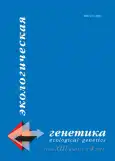Анализ полиморфизма d-петли митохондриальной ДНК для оценки популяционного разнообразия кур породы Павловская
- Авторы: Демин А.Г.1, Данилова М.И.1, Галкина С.А.1
-
Учреждения:
- ФГБОУ ВПО «Санкт-Петербургский государственный университет»
- Выпуск: Том 13, № 4 (2015)
- Страницы: 68-75
- Раздел: Статьи
- URL: https://journals.rcsi.science/ecolgenet/article/view/2440
- DOI: https://doi.org/10.17816/ecogen13468-75
- ID: 2440
Цитировать
Полный текст
Аннотация
Ключевые слова
Полный текст
Открыть статью на сайте журналаОб авторах
Александр Геннадьевич Демин
ФГБОУ ВПО «Санкт-Петербургский государственный университет»
Email: rustle.reed@gmail.com
к. б. н., стажер-исследователь, кафедра цитологии и гистологии
Мария Игоревна Данилова
ФГБОУ ВПО «Санкт-Петербургский государственный университет»
Email: noxforest@yandex.ru
студент, кафедра цитологии и гистологии
Светлана Анатольевна Галкина
ФГБОУ ВПО «Санкт-Петербургский государственный университет»
Email: svetlana.galkina@spbu.ru
к. б. н., доцент, кафедра цитологии и гистологии
Список литературы
- Моисеева И. Г. (2006) Породы кур и их генофонды. Под ред. И. А. Захарова. Генетические ресурсы животноводства России. Москва. Наука; С. 229-388.
- Серебровский А. С. (1976) Генетический очерк павловской породы кур. Избранные труды по генетике и селекции кур. Москва. Наука; C. 356-378.
- Bandelt H.-J., Forster P., Rohl A. (1999) Median-joining networks for inferring intraspecific phylogenies. Mol Biol Evol. V. 16: P. 37-48.
- Berthouly-Salazar C., Rognon X., Van T. et al. (2010) Vietnamese chickens: a gate towards Asian genetic diversity. BMC Genet. V. 18 (11). Cited 5.11.2015. doi: 10.1186/1471-2156-11-53.
- Dana N., Megens H. J., Crooijmans R. P. et al. (2011) East Asian contributions to Dutch traditional and western commercial chickens inferred from mtDNA analysis. Anim Genet. V. 42 (2): P. 125-133.
- Froman D. P., Kirby J. D. (2005) Sperm mobility: phenotype in roosters (Gallus domesticus) determined by mitochondrial function. Biol Reprod. V. 72 (3): P. 562-567.
- Fumihito A., Miyake T., Sumi S. et al. (1994) One subspecies of the red jungle fowl (Gallus gallus gallus) fices as the matriarchic ancestor of all domestic breeds. Proc. Natl. Acad. Sci. USA. V. 91 (26): P. 12505-12509.
- Fumihito A., Miyake T., Takada M. et al. (1996) Monophyletic origin and unique dispersal patterns of domestic fowls. Proc. Natl. Acad. Sci. USA. V. 93 (13): P. 6792-6795.
- Girdland Flink L., Allen R., Barnett R. et al. (2014) Establishing the validity of domestication genes using DNA from ancient chickens. Proc Natl Acad Sci USA. V. 111 (17): P. 6184-6189.
- Hall T. A. (1999) BioEdit: a user friendly biological sequence alignment editor and analysis program for Windows 95/98/NT. Nucleic Acid Symposium Series. V. 41: P. 95-98.
- Hoque M. R., Choi N. R., Sultana H. et al. (2013) Phylogenetic analysis of a privately-owned Korean native chicken populations using mtDNA D-loop variations. Asian-Australas J Anim Sci. V. 26 (2): P. 157-162.
- Kanginakudru S., Metta M., Jakati R. D., Nagaraju J. (2008) Genetic evidence from Indian red jungle fowl corroborates multiple domestication of modern day chicken. BMC Evol Biol. V. 8 (174). Cited 5.11.2015. doi: 10.1186/1471-2148-8-174.
- Liu Z. G., Lei C. Z., Luo J. et al. (2004) Genetic variability of mtDNA sequences in Chinese native chicken breeds. Asian-Aust. J. Anim. Sci. V. 17: P. 903-907.
- Liu Y. P., Wu G. S., Yao Y. G. et al. (2006) Multiple maternal origins of chickens: out of the Asian jungles. Mol Phylogenet Evol. V. 38 (1): P. 12-9.
- Lynch M. (2007) The origins of genome architecture. Sunderland. MA: Sinauer Associates, Inc. Publishers.
- Miao Y.-W., Peng M.-S., Wu G-S. et al. (2013) Chicken domestication: an updated perspective based on mitochondrial genomes. Heredity (Edinb). V. 110 (3): P. 277-282.
- Muchadeyi F. C., Eding H., Simianer H. et al. (2008) Mitochondrial DNA D-loop sequences suggest a Southeast Asian and Indian origin of Zimbabwean village chickens. Anim Genet. V. 39 (6): P. 615-622.
- Mwacharo J. M., Bjørnstad G., Mobegi V. et al. (2011) Mitochondrial DNA reveals multiple introductions of domestic chicken in East Africa. Mol Phylogenet Evol. V. 58 (2): 374-382. Cited 5.11.2015. doi: 10.1016/j.ympev.2010.11.027.
- Nei M. (1973) Analysis of gene diversity in subdivided populations. Proc Natl Acad Sci USA. V. 70 (12): P. 3321-3323.
- Niu D., Fu Y., Luo J. et al. (2002) The origin and genetic diversity of Chinese native chicken breeds. Biochem. Genet. V. 40 (5-6): P. 163-174.
- Nishibori M., Tsudzuki M., Hayashi T. et al. (2002) Complete nucleotide sequence of the Coturnix chinensis (blue-breasted quail) mitochondrial genome and a phylogenetic analysis with related species. J Hered. V. 93 (6): P. 439-444.
- Nishibori M., Shimogiri T., Hayashi T., Yasue H. (2005) Molecular evidence for hybridization of species in the genus Gallus except for Gallus varius. Animal Genetics. V. 36: P. 367-375.
- Oka T., Ino Y., Nomura K. et al. (2007) Analysis of mtDNA sequences shows Japanese native chickens have multiple origins. Anim Genet. V. 38 (3): P. 287-293.
- Qu L., Li X., Xu G. et al. (2006) Evaluation of genetic diversity in Chinese indigenous chicken breeds using microsatellite markers. Science in China Series C: Life Sciences. V. 49 (4): P. 332-341.
- Ramadan H. A. I., Galal A., Fathi M. M. et al. (2011) Characterization of two Egyptian native chicken breeds using genetic and immunological parameters. Biotechnology in Animal Husbandry. V. 27 (1): P. 1-16.
- Revay T., Bodzsar N., Mobegi V. E. et al. (2010) Origin of Hungarian indigenous chicken breeds inferred from mitochondrial DNA D-loopsequences. Animal Genetics. V. 41: P. 548-550.
- Rozas J., Sánchez-DelBarrio J. C., Messeguer X., Rozas R. (2003) DnaSP, DNA polymorphism analyses by the coalescent and other methods. Bioinformatics. V. 19 (18): P. 2496-2497.
- Stoneking M., Hedgecock D., Higuchi R. G. et al. (1991) Population variation of human mtDNA control region sequences detected by enzymatic amplification and sequence-specific oligonucleotide probes. Am J Hum Genet. V. 48 (2): P. 370-382.
- Storey A. A., Athens J. S., Bryant D. et al. (2012) Investigating the global dispersal of chickens in prehistory using ancient mitochondrial DNA signatures. PLoS ONE. V. 7 (7): e39171. Cited 5.11.2015. doi: 10.1371/journal.pone.0039171.
- Wu Y. P., Huo J. H., Xie J. F. et al. (2014) Phylogeography and origin of Chinese domestic chicken. Mitochondrial DNA. V. 25 (2): P. 126-130.
Дополнительные файлы






